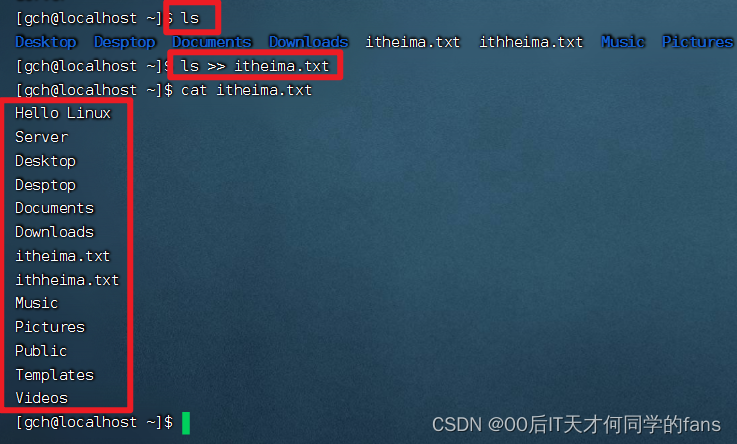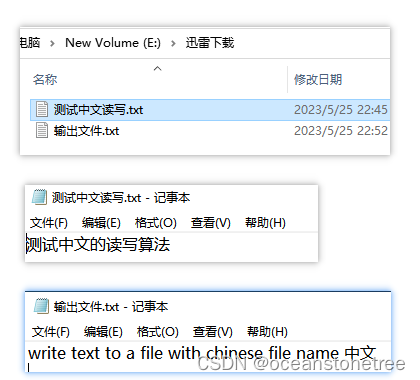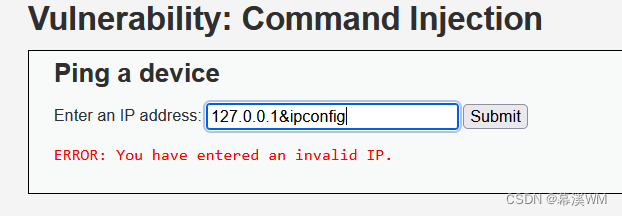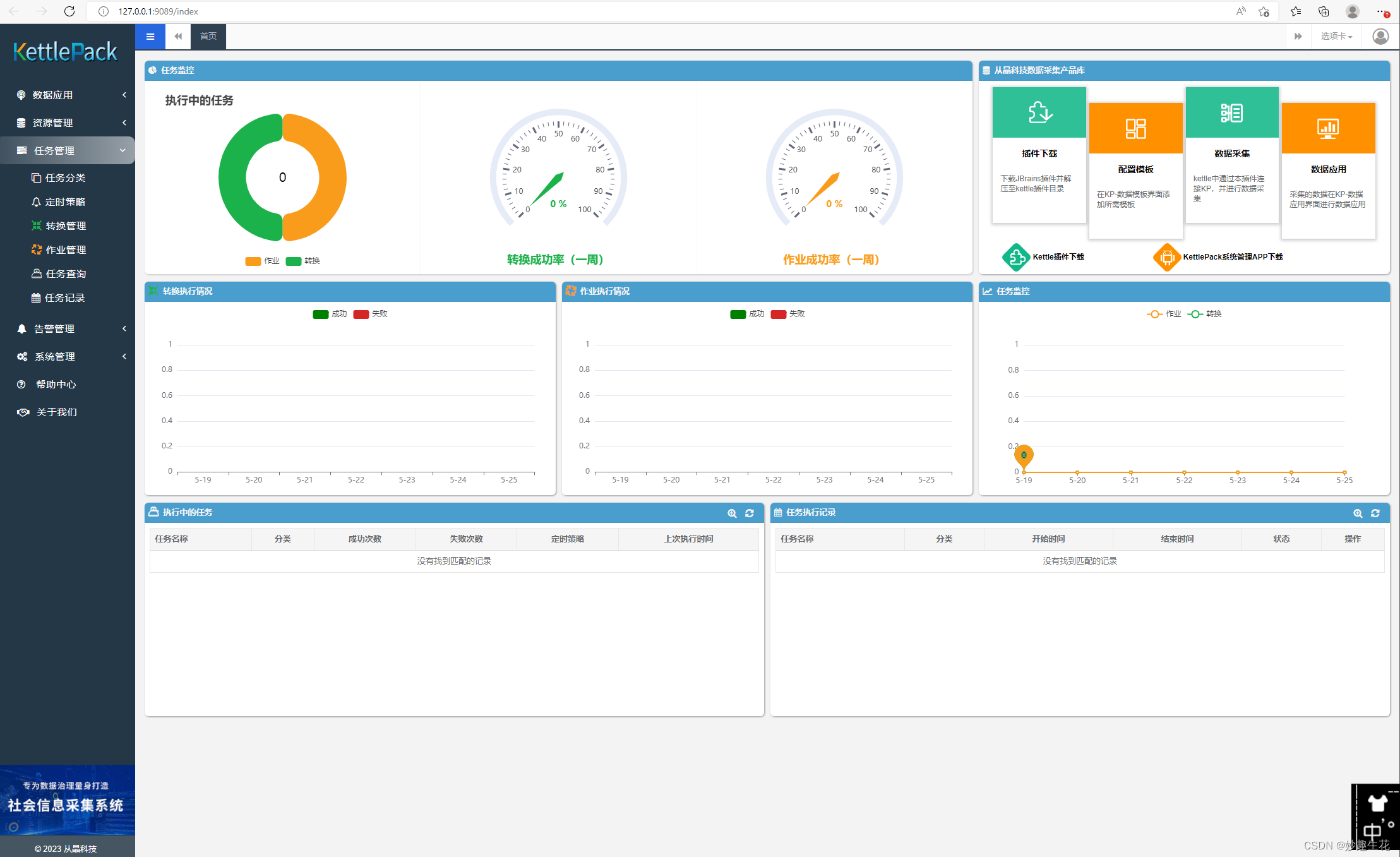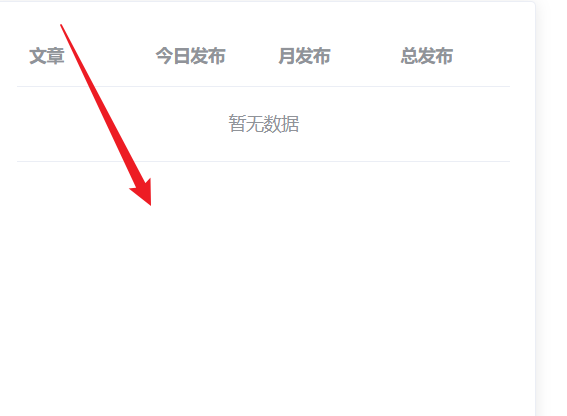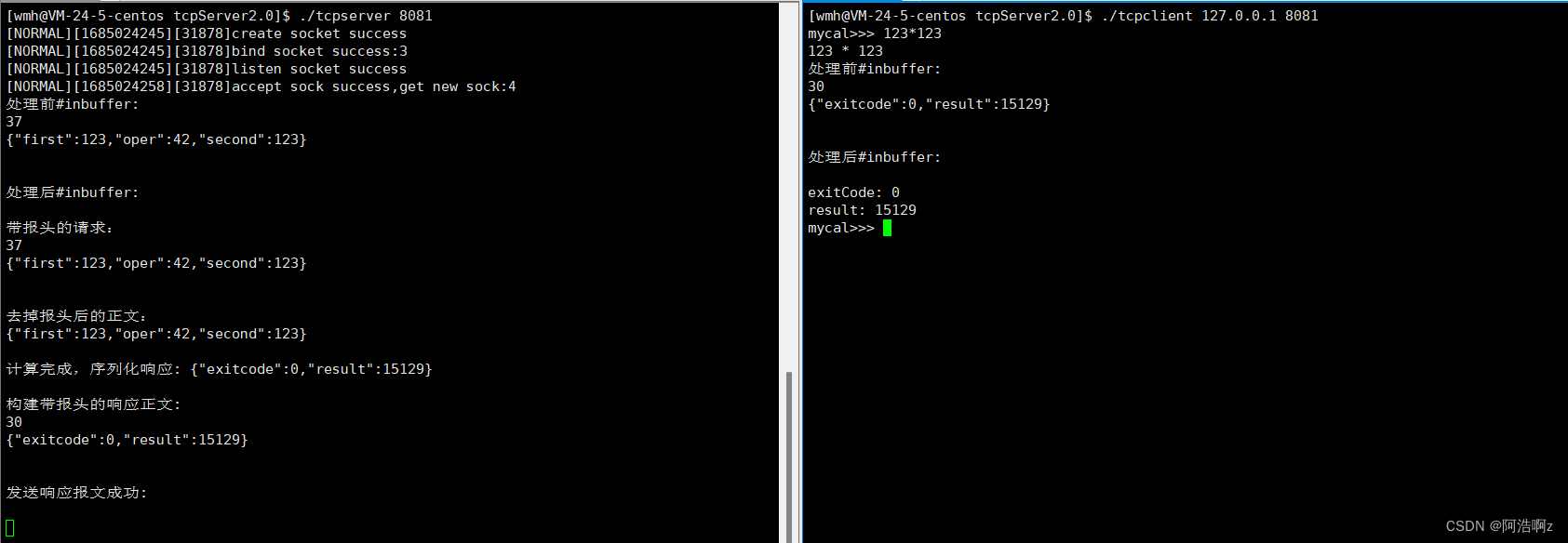阿里云相关文档
1、在ACK管理控制台点击如下
应用市场–>筛选(以ack-ingress-nginx-v1为例)–>点击安装–>一键部署–>自己定义集群、命名空间以及ingress名称
1.20以下集群选中ack-ingress-nginx。
1.20及以上集群选中ack-ingress-nginx-v1。
应用市场
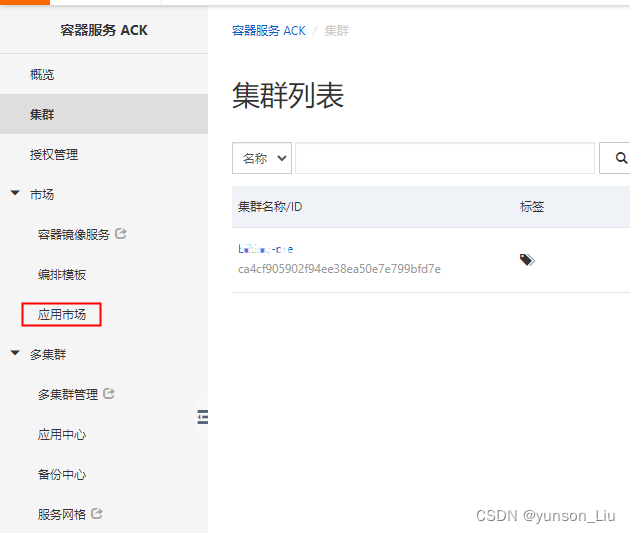
筛选(以ack-ingress-nginx-v1为例)并点击安装
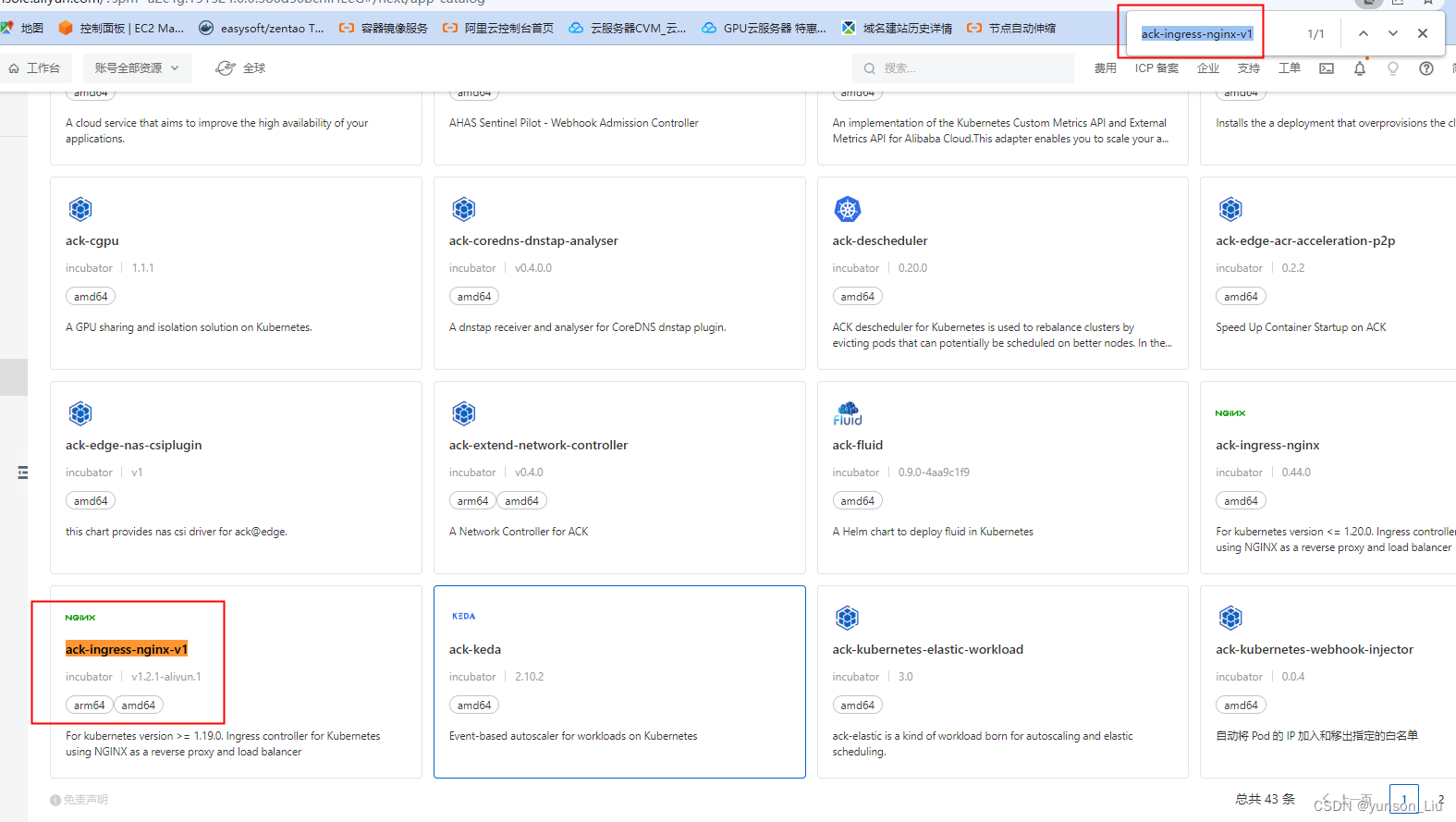
一键部署
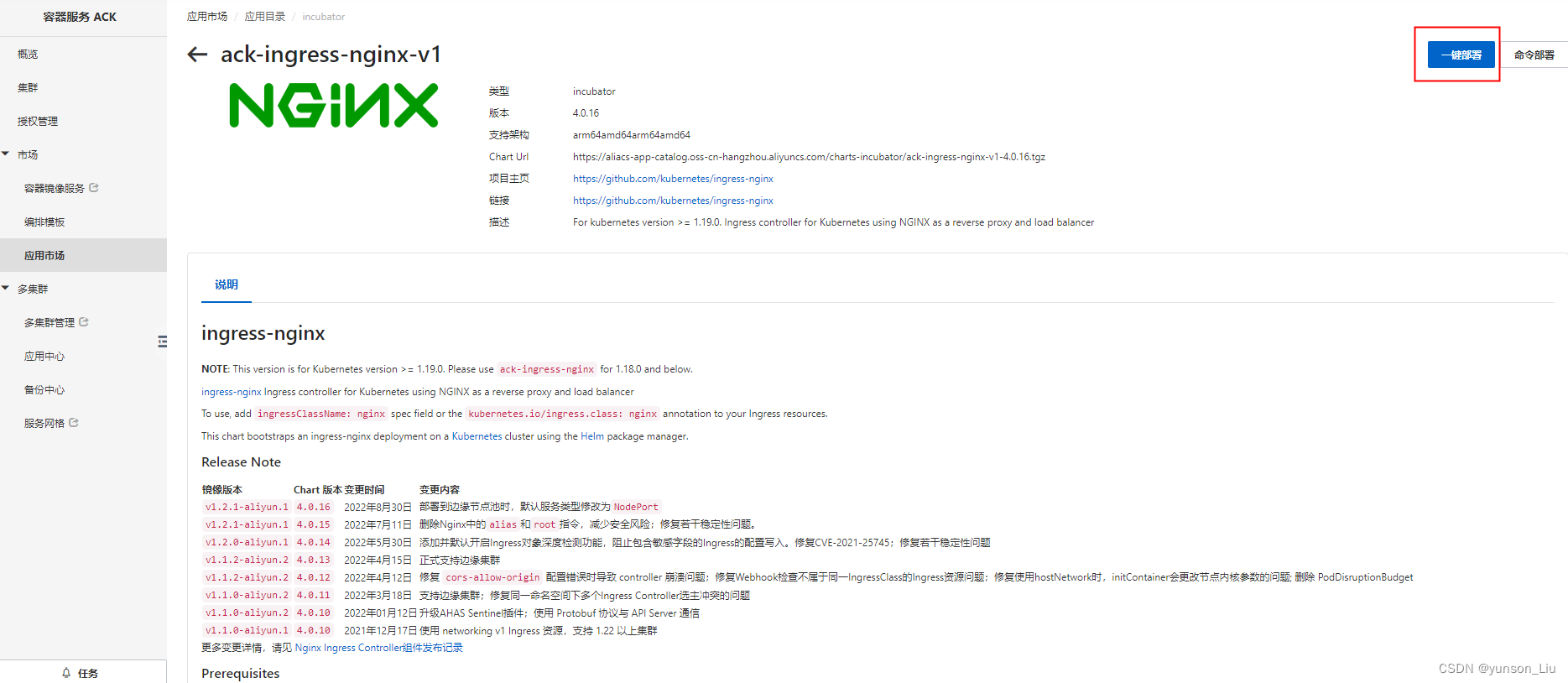
自己定义集群、命名空间以及ingress名称

默认不动点击确定
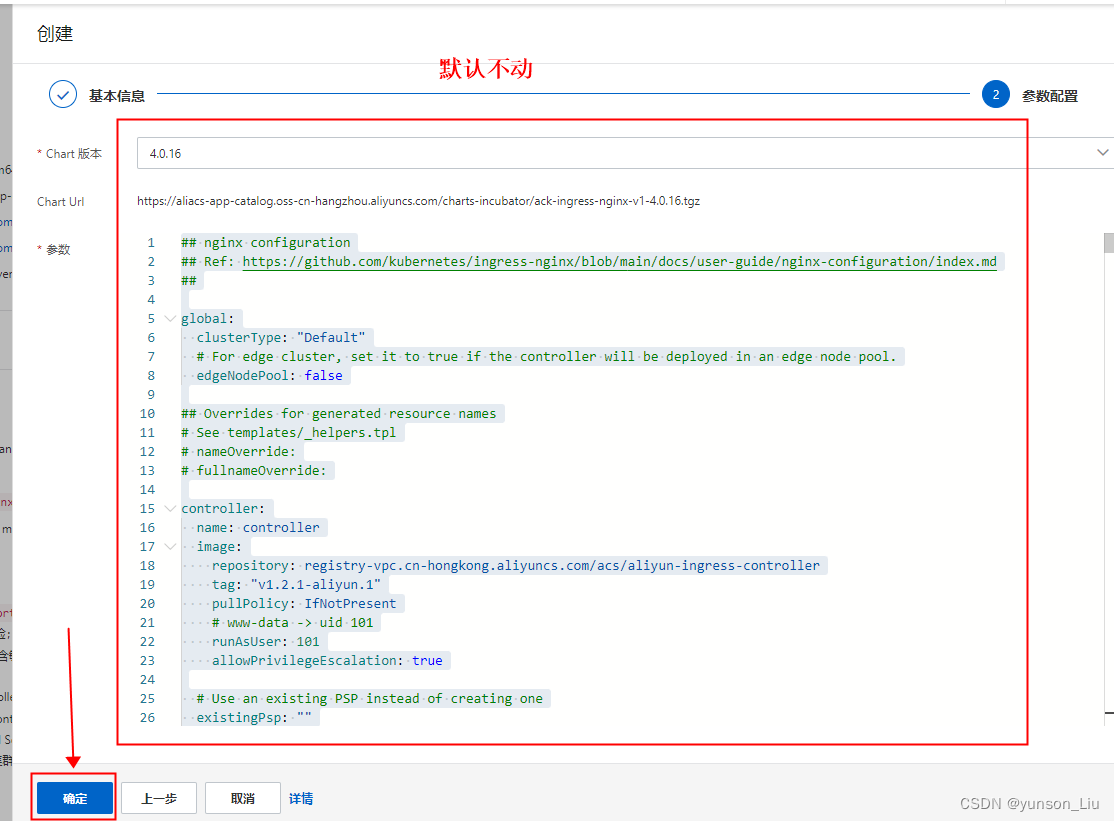
默认值如下
## nginx configuration
## Ref: https://github.com/kubernetes/ingress-nginx/blob/main/docs/user-guide/nginx-configuration/index.md
##
global:
clusterType: "Default"
# For edge cluster, set it to true if the controller will be deployed in an edge node pool.
edgeNodePool: false
## Overrides for generated resource names
# See templates/_helpers.tpl
# nameOverride:
# fullnameOverride:
controller:
name: controller
image:
repository: registry-vpc.cn-hongkong.aliyuncs.com/acs/aliyun-ingress-controller
tag: "v1.2.1-aliyun.1"
pullPolicy: IfNotPresent
# www-data -> uid 101
runAsUser: 101
allowPrivilegeEscalation: true
# Use an existing PSP instead of creating one
existingPsp: ""
# Configures the controller container name
containerName: controller
# Configures the ports the nginx-controller listens on
containerPort:
http: 80
https: 443
# Will add custom configuration options to Nginx https://kubernetes.github.io/ingress-nginx/user-guide/nginx-configuration/configmap/
config:
log-format-upstream: '$remote_addr - [$remote_addr] - $remote_user [$time_local] "$request" $status $body_bytes_sent "$http_referer" "$http_user_agent" $request_length $request_time [$proxy_upstream_name] $upstream_addr $upstream_response_length $upstream_response_time $upstream_status $req_id $host [$proxy_alternative_upstream_name]'
proxy-body-size: 20m
proxy-connect-timeout: "10"
max-worker-connections: "65536"
enable-underscores-in-headers: "true"
reuse-port: "true"
worker-cpu-affinity: "auto"
server-tokens: "false"
ssl-redirect: "false"
allow-backend-server-header: "true"
ignore-invalid-headers: "true"
generate-request-id: "true"
upstream-keepalive-timeout: "900"
# This section refers to the creation of the IngressClass resource
# IngressClass resources are supported since k8s >= 1.18 and required since k8s >= 1.19
ingressClassResource:
# name & controllerValue is used instead of ingressClass,
# and name can be also used in kubernetes.io/ingress.class annotation.
# prevent override of default ingress class in addon, controllerValue's default value is 'k8s.io/ack-ingress-nginx',
# and default name is 'ack-nginx'.
# please both modiy name and controllerValue to unique values.
name: ack-nginx
controllerValue: "k8s.io/ack-ingress-nginx"
enabled: true
default: false
# Parameters is a link to a custom resource containing additional
# configuration for the controller. This is optional if the controller
# does not require extra parameters.
parameters: {}
# Process Ingress objects without ingressClass annotation/ingressClassName field
# Overrides value for --watch-ingress-without-class flag of the controller binary
# Defaults to false
watchIngressWithoutClass: false
# Process IngressClass per name (additionally as per spec.controller)
ingressClassByName: false
service:
# enable internet or intranet slb
enabled: true
external:
# enable internet slb
enabled: true
# internet slb annotations
annotations:
service.beta.kubernetes.io/alibaba-cloud-loadbalancer-address-type: "internet"
service.beta.kubernetes.io/alibaba-cloud-loadbalancer-spec: "slb.s1.small"
## Enables an additional internal load balancer (besides the external one).
## Annotations are mandatory for the load balancer to come up. Varies with the cloud service.
internal:
# enable intranet slb
enabled: false
# intranet slb annotations
annotations:
service.beta.kubernetes.io/alibaba-cloud-loadbalancer-address-type: "intranet"
service.beta.kubernetes.io/alibaba-cloud-loadbalancer-spec: "slb.s1.small"
# loadBalancerIP: ""
## Restrict access For LoadBalancer service. Defaults to 0.0.0.0/0.
loadBalancerSourceRanges: []
## Set external traffic policy to: "Local" to preserve source IP on
## providers supporting it
## Ref: https://kubernetes.io/docs/tutorials/services/source-ip/#source-ip-for-services-with-typeloadbalancer
externalTrafficPolicy: "Cluster"
labels: {}
# clusterIP: ""
## List of IP addresses at which the controller services are available
## Ref: https://kubernetes.io/docs/user-guide/services/#external-ips
##
externalIPs: []
# loadBalancerIP: ""
loadBalancerSourceRanges: []
enableHttp: true
enableHttps: true
## Set external traffic policy to: "Local" to preserve source IP on providers supporting it.
## Ref: https://kubernetes.io/docs/tutorials/services/source-ip/#source-ip-for-services-with-typeloadbalancer
externalTrafficPolicy: "Local"
## Must be either "None" or "ClientIP" if set. Kubernetes will default to "None".
## Ref: https://kubernetes.io/docs/concepts/services-networking/service/#virtual-ips-and-service-proxies
# sessionAffinity: ""
## Specifies the health check node port (numeric port number) for the service. If healthCheckNodePort isn’t specified,
## the service controller allocates a port from your cluster’s NodePort range.
## Ref: https://kubernetes.io/docs/tasks/access-application-cluster/create-external-load-balancer/#preserving-the-client-source-ip
# healthCheckNodePort: 0
## Represents the dual-stack-ness requested or required by this Service. Possible values are
## SingleStack, PreferDualStack or RequireDualStack.
## The ipFamilies and clusterIPs fields depend on the value of this field.
## Ref: https://kubernetes.io/docs/concepts/services-networking/dual-stack/
ipFamilyPolicy: "SingleStack"
## List of IP families (e.g. IPv4, IPv6) assigned to the service. This field is usually assigned automatically
## based on cluster configuration and the ipFamilyPolicy field.
## Ref: https://kubernetes.io/docs/concepts/services-networking/dual-stack/
ipFamilies:
- IPv4
ports:
http: 80
https: 443
targetPorts:
http: 80
https: 443
type: LoadBalancer
# type: NodePort
# nodePorts:
# http: 32080
# https: 32443
# tcp:
# 8080: 32808
nodePorts:
http: ""
https: ""
tcp: {}
udp: {}
## Node labels for controller pod assignment
## Ref: https://kubernetes.io/docs/user-guide/node-selection/
##
nodeSelector:
kubernetes.io/os: linux
## Node tolerations for server scheduling to nodes with taints
## Ref: https://kubernetes.io/docs/concepts/configuration/assign-pod-node/
##
tolerations:
- key: "node-role.alibabacloud.com/addon"
operator: "Exists"
effect: "NoSchedule"
## Annotations to be added to the controller config configuration configmap
##
configAnnotations: {}
# Will add custom headers before sending traffic to backends according to https://github.com/kubernetes/ingress-nginx/tree/main/docs/examples/customization/custom-headers
proxySetHeaders: {}
# Will add custom headers before sending response traffic to the client according to: https://kubernetes.github.io/ingress-nginx/user-guide/nginx-configuration/configmap/#add-headers
addHeaders: {}
# Optionally customize the pod dnsConfig.
dnsConfig: {}
# Optionally customize the pod hostname.
hostname: {}
# Optionally change this to ClusterFirstWithHostNet in case you have 'hostNetwork: true'.
# By default, while using host network, name resolution uses the host's DNS. If you wish nginx-controller
# to keep resolving names inside the k8s network, use ClusterFirstWithHostNet.
dnsPolicy: ClusterFirst
# Bare-metal considerations via the host network https://kubernetes.github.io/ingress-nginx/deploy/baremetal/#via-the-host-network
# Ingress status was blank because there is no Service exposing the NGINX Ingress controller in a configuration using the host network, the default --publish-service flag used in standard cloud setups does not apply
reportNodeInternalIp: false
# This configuration defines if Ingress Controller should allow users to set
# their own *-snippet annotations, otherwise this is forbidden / dropped
# when users add those annotations.
# Global snippets in ConfigMap are still respected
allowSnippetAnnotations: true
# Required for use with CNI based kubernetes installations (such as ones set up by kubeadm),
# since CNI and hostport don't mix yet. Can be deprecated once https://github.com/kubernetes/kubernetes/issues/23920
# is merged
hostNetwork: false
## Use host ports 80 and 443
## Disabled by default
##
hostPort:
enabled: false
ports:
http: 80
https: 443
## Election ID to use for status update
##
electionID: ingress-controller-leader
# labels to add to the pod container metadata
podLabels: {}
# key: value
## Security Context policies for controller pods
##
podSecurityContext: {}
## See https://kubernetes.io/docs/tasks/administer-cluster/sysctl-cluster/ for
## notes on enabling and using sysctls
###
sysctls: {}
# sysctls:
# "net.core.somaxconn": "8192"
## Allows customization of the source of the IP address or FQDN to report
## in the ingress status field. By default, it reads the information provided
## by the service. If disable, the status field reports the IP address of the
## node or nodes where an ingress controller pod is running.
publishService:
enabled: true
## Allows overriding of the publish service to bind to
## Must be <namespace>/<service_name>
##
pathOverride: ""
## Limit the scope of the controller
##
scope:
enabled: false
namespace: "" # defaults to $(POD_NAMESPACE)
# When scope.enabled == false, instead of watching all namespaces, we watching namespaces whose labels
# only match with namespaceSelector. Format like foo=bar. Defaults to empty, means watching all namespaces.
namespaceSelector: ""
## Allows customization of the configmap / nginx-configmap namespace
##
configMapNamespace: "" # defaults to $(POD_NAMESPACE)
## Allows customization of the tcp-services-configmap
##
tcp:
configMapNamespace: "" # defaults to $(POD_NAMESPACE)
## Annotations to be added to the tcp config configmap
annotations: {}
## Allows customization of the udp-services-configmap
##
udp:
configMapNamespace: "" # defaults to $(POD_NAMESPACE)
## Annotations to be added to the udp config configmap
annotations: {}
# Maxmind license key to download GeoLite2 Databases
# https://blog.maxmind.com/2019/12/18/significant-changes-to-accessing-and-using-geolite2-databases
maxmindLicenseKey: ""
## Additional command line arguments to pass to nginx-ingress-controller
## E.g. to specify the default SSL certificate you can use
## extraArgs:
## default-ssl-certificate: "<namespace>/<secret_name>"
extraArgs:
v: "2"
## Additional environment variables to set
extraEnvs: []
# extraEnvs:
# - name: FOO
# valueFrom:
# secretKeyRef:
# key: FOO
# name: secret-resource
## DaemonSet or Deployment
##
kind: Deployment
## Annotations to be added to the controller Deployment or DaemonSet
##
annotations: {}
# keel.sh/pollSchedule: "@every 60m"
## Labels to be added to the controller Deployment or DaemonSet and other resources that do not have option to specify labels
##
labels: {}
# keel.sh/policy: patch
# keel.sh/trigger: poll
# The update strategy to apply to the Deployment or DaemonSet
##
updateStrategy: {}
# rollingUpdate:
# maxUnavailable: 1
# type: RollingUpdate
# minReadySeconds to avoid killing pods before we are ready
##
minReadySeconds: 0
## Affinity and anti-affinity
## Ref: https://kubernetes.io/docs/concepts/configuration/assign-pod-node/#affinity-and-anti-affinity
##
affinity: {}
# # An example of preferred pod anti-affinity, weight is in the range 1-100
# podAntiAffinity:
# preferredDuringSchedulingIgnoredDuringExecution:
# - weight: 100
# podAffinityTerm:
# labelSelector:
# matchExpressions:
# - key: app.kubernetes.io/name
# operator: In
# values:
# - ingress-nginx
# - key: app.kubernetes.io/instance
# operator: In
# values:
# - ingress-nginx
# - key: app.kubernetes.io/component
# operator: In
# values:
# - controller
# topologyKey: kubernetes.io/hostname
# # An example of required pod anti-affinity
# podAntiAffinity:
# requiredDuringSchedulingIgnoredDuringExecution:
# - labelSelector:
# matchExpressions:
# - key: app.kubernetes.io/name
# operator: In
# values:
# - ingress-nginx
# - key: app.kubernetes.io/instance
# operator: In
# values:
# - ingress-nginx
# - key: app.kubernetes.io/component
# operator: In
# values:
# - controller
# topologyKey: "kubernetes.io/hostname"
## Topology spread constraints rely on node labels to identify the topology domain(s) that each Node is in.
## Ref: https://kubernetes.io/docs/concepts/workloads/pods/pod-topology-spread-constraints/
##
topologySpreadConstraints: []
# - maxSkew: 1
# topologyKey: failure-domain.beta.kubernetes.io/zone
# whenUnsatisfiable: DoNotSchedule
# labelSelector:
# matchLabels:
# app.kubernetes.io/instance: ingress-nginx-internal
## terminationGracePeriodSeconds
## wait up to five minutes for the drain of connections
##
terminationGracePeriodSeconds: 300
## Liveness and readiness probe values
## Ref: https://kubernetes.io/docs/concepts/workloads/pods/pod-lifecycle/#container-probes
##
# startupProbe:
# httpGet:
# # should match container.healthCheckPath
# path: "/healthz"
# port: 10254
# scheme: HTTP
# initialDelaySeconds: 5
# periodSeconds: 5
# timeoutSeconds: 2
# successThreshold: 1
# failureThreshold: 5
livenessProbe:
httpGet:
# should match container.healthCheckPath
path: "/healthz"
port: 10254
scheme: HTTP
initialDelaySeconds: 10
periodSeconds: 10
timeoutSeconds: 1
successThreshold: 1
failureThreshold: 5
readinessProbe:
httpGet:
# should match container.healthCheckPath
path: "/healthz"
port: 10254
scheme: HTTP
initialDelaySeconds: 10
periodSeconds: 10
timeoutSeconds: 1
successThreshold: 1
failureThreshold: 3
# Path of the health check endpoint. All requests received on the port defined by
# the healthz-port parameter are forwarded internally to this path.
healthCheckPath: "/healthz"
# Address to bind the health check endpoint.
# It is better to set this option to the internal node address
# if the ingress nginx controller is running in the hostNetwork: true mode.
healthCheckHost: ""
## Annotations to be added to controller pods
##
podAnnotations: {}
replicaCount: 2
minAvailable: 1
# Define requests resources to avoid probe issues due to CPU utilization in busy nodes
# ref: https://github.com/kubernetes/ingress-nginx/issues/4735#issuecomment-551204903
# Ideally, there should be no limits.
# https://engineering.indeedblog.com/blog/2019/12/cpu-throttling-regression-fix/
resources:
# limits:
# cpu: 100m
# memory: 90Mi
requests:
cpu: 100m
memory: 90Mi
# Mutually exclusive with keda autoscaling
autoscaling:
enabled: false
minReplicas: 1
maxReplicas: 11
targetCPUUtilizationPercentage: 50
targetMemoryUtilizationPercentage: 50
behavior: {}
# scaleDown:
# stabilizationWindowSeconds: 300
# policies:
# - type: Pods
# value: 1
# periodSeconds: 180
# scaleUp:
# stabilizationWindowSeconds: 300
# policies:
# - type: Pods
# value: 2
# periodSeconds: 60
autoscalingTemplate: []
# Custom or additional autoscaling metrics
# ref: https://kubernetes.io/docs/tasks/run-application/horizontal-pod-autoscale/#support-for-custom-metrics
# - type: Pods
# pods:
# metric:
# name: nginx_ingress_controller_nginx_process_requests_total
# target:
# type: AverageValue
# averageValue: 10000m
# Mutually exclusive with hpa autoscaling
keda:
apiVersion: "keda.sh/v1alpha1"
# apiVersion changes with keda 1.x vs 2.x
# 2.x = keda.sh/v1alpha1
# 1.x = keda.k8s.io/v1alpha1
enabled: false
minReplicas: 1
maxReplicas: 11
pollingInterval: 30
cooldownPeriod: 300
restoreToOriginalReplicaCount: false
scaledObject:
annotations: {}
# Custom annotations for ScaledObject resource
# annotations:
# key: value
triggers: []
# - type: prometheus
# metadata:
# serverAddress: http://<prometheus-host>:9090
# metricName: http_requests_total
# threshold: '100'
# query: sum(rate(http_requests_total{deployment="my-deployment"}[2m]))
behavior: {}
# scaleDown:
# stabilizationWindowSeconds: 300
# policies:
# - type: Pods
# value: 1
# periodSeconds: 180
# scaleUp:
# stabilizationWindowSeconds: 300
# policies:
# - type: Pods
# value: 2
# periodSeconds: 60
## Enable mimalloc as a drop-in replacement for malloc.
## ref: https://github.com/microsoft/mimalloc
##
enableMimalloc: true
## Override NGINX template
customTemplate:
configMapName: ""
configMapKey: ""
extraContainers: []
## Additional containers to be added to the controller pod.
## See https://github.com/lemonldap-ng-controller/lemonldap-ng-controller as example.
# - name: my-sidecar
# image: nginx:latest
# - name: lemonldap-ng-controller
# image: lemonldapng/lemonldap-ng-controller:0.2.0
# args:
# - /lemonldap-ng-controller
# - --alsologtostderr
# - --configmap=$(POD_NAMESPACE)/lemonldap-ng-configuration
# env:
# - name: POD_NAME
# valueFrom:
# fieldRef:
# fieldPath: metadata.name
# - name: POD_NAMESPACE
# valueFrom:
# fieldRef:
# fieldPath: metadata.namespace
# volumeMounts:
# - name: copy-portal-skins
# mountPath: /srv/var/lib/lemonldap-ng/portal/skins
extraVolumeMounts:
## Additional volumeMounts to the controller main container.
# - name: copy-portal-skins
# mountPath: /var/lib/lemonldap-ng/portal/skins
- name: localtime
mountPath: /etc/localtime
readOnly: true
extraVolumes:
## Additional volumes to the controller pod.
# - name: copy-portal-skins
# emptyDir: {}
- name: localtime
hostPath:
path: /etc/localtime
type: File
extraInitContainers:
## Containers, which are run before the app containers are started.
# - name: init-myservice
# image: busybox
# command: ['sh', '-c', 'until nslookup myservice; do echo waiting for myservice; sleep 2; done;']
- name: init-sysctl
image: registry-vpc.cn-hongkong.aliyuncs.com/acs/busybox:v1.29.2
command:
- /bin/sh
- -c
- |
if [ "$POD_IP" != "$HOST_IP" ]; then
mount -o remount rw /proc/sys
sysctl -w net.core.somaxconn=65535
sysctl -w net.ipv4.ip_local_port_range="1024 65535"
sysctl -w kernel.core_uses_pid=0
fi
securityContext:
capabilities:
drop:
- ALL
add:
- SYS_ADMIN
env:
- name: POD_IP
valueFrom:
fieldRef:
fieldPath: status.podIP
- name: HOST_IP
valueFrom:
fieldRef:
fieldPath: status.hostIP
admissionWebhooks:
annotations: {}
enabled: true
failurePolicy: Fail
# timeoutSeconds: 10
port: 8443
certificate: "/usr/local/certificates/cert"
key: "/usr/local/certificates/key"
namespaceSelector: {}
objectSelector: {}
## Labels to be added to admission webhooks
labels: {}
service:
annotations: {}
# clusterIP: ""
externalIPs: []
# loadBalancerIP: ""
loadBalancerSourceRanges: []
servicePort: 443
type: ClusterIP
createSecretJob:
resources: {}
# limits:
# cpu: 10m
# memory: 20Mi
# requests:
# cpu: 10m
# memory: 20Mi
patchWebhookJob:
resources: {}
patch:
enabled: true
image:
repository: registry-vpc.cn-hongkong.aliyuncs.com/acs/kube-webhook-certgen
tag: v1.1.1
pullPolicy: IfNotPresent
## Provide a priority class name to the webhook patching job
##
priorityClassName: ""
podAnnotations: {}
nodeSelector:
kubernetes.io/os: linux
tolerations:
- key: "node-role.alibabacloud.com/addon"
operator: "Exists"
effect: "NoSchedule"
## Labels to be added to patch job resources
labels: {}
runAsUser: 2000
metrics:
port: 10254
# if this port is changed, change healthz-port: in extraArgs: accordingly
enabled: false
service:
annotations: {}
# prometheus.io/scrape: "true"
# prometheus.io/port: "10254"
# clusterIP: ""
## List of IP addresses at which the stats-exporter service is available
## Ref: https://kubernetes.io/docs/user-guide/services/#external-ips
##
externalIPs: []
# loadBalancerIP: ""
loadBalancerSourceRanges: []
servicePort: 10254
type: ClusterIP
# externalTrafficPolicy: ""
# nodePort: ""
serviceMonitor:
enabled: false
additionalLabels: {}
# The label to use to retrieve the job name from.
# jobLabel: "app.kubernetes.io/name"
namespace: ""
namespaceSelector: {}
# Default: scrape .Release.Namespace only
# To scrape all, use the following:
# namespaceSelector:
# any: true
scrapeInterval: 30s
# honorLabels: true
targetLabels: []
metricRelabelings: []
prometheusRule:
enabled: false
additionalLabels: {}
# namespace: ""
rules: []
# # These are just examples rules, please adapt them to your needs
# - alert: NGINXConfigFailed
# expr: count(nginx_ingress_controller_config_last_reload_successful == 0) > 0
# for: 1s
# labels:
# severity: critical
# annotations:
# description: bad ingress config - nginx config test failed
# summary: uninstall the latest ingress changes to allow config reloads to resume
# - alert: NGINXCertificateExpiry
# expr: (avg(nginx_ingress_controller_ssl_expire_time_seconds) by (host) - time()) < 604800
# for: 1s
# labels:
# severity: critical
# annotations:
# description: ssl certificate(s) will expire in less then a week
# summary: renew expiring certificates to avoid downtime
# - alert: NGINXTooMany500s
# expr: 100 * ( sum( nginx_ingress_controller_requests{status=~"5.+"} ) / sum(nginx_ingress_controller_requests) ) > 5
# for: 1m
# labels:
# severity: warning
# annotations:
# description: Too many 5XXs
# summary: More than 5% of all requests returned 5XX, this requires your attention
# - alert: NGINXTooMany400s
# expr: 100 * ( sum( nginx_ingress_controller_requests{status=~"4.+"} ) / sum(nginx_ingress_controller_requests) ) > 5
# for: 1m
# labels:
# severity: warning
# annotations:
# description: Too many 4XXs
# summary: More than 5% of all requests returned 4XX, this requires your attention
## Improve connection draining when ingress controller pod is deleted using a lifecycle hook:
## With this new hook, we increased the default terminationGracePeriodSeconds from 30 seconds
## to 300, allowing the draining of connections up to five minutes.
## If the active connections end before that, the pod will terminate gracefully at that time.
## To effectively take advantage of this feature, the Configmap feature
## worker-shutdown-timeout new value is 240s instead of 10s.
##
lifecycle:
preStop:
exec:
command:
- /wait-shutdown
priorityClassName: ""
## Rollback limit
##
revisionHistoryLimit: 10
## Default 404 backend
##
defaultBackend:
##
enabled: false
name: defaultbackend
image:
registry: k8s.gcr.io
image: defaultbackend-amd64
# for backwards compatibility consider setting the full image url via the repository value below
# use *either* current default registry/image or repository format or installing chart by providing the values.yaml will fail
# repository:
tag: "1.5"
pullPolicy: IfNotPresent
# nobody user -> uid 65534
runAsUser: 65534
runAsNonRoot: true
readOnlyRootFilesystem: true
allowPrivilegeEscalation: false
extraArgs: {}
serviceAccount:
create: true
name: ""
automountServiceAccountToken: true
## Additional environment variables to set for defaultBackend pods
extraEnvs: []
port: 8080
## Readiness and liveness probes for default backend
## Ref: https://kubernetes.io/docs/tasks/configure-pod-container/configure-liveness-readiness-probes/
##
livenessProbe:
failureThreshold: 3
initialDelaySeconds: 30
periodSeconds: 10
successThreshold: 1
timeoutSeconds: 5
readinessProbe:
failureThreshold: 6
initialDelaySeconds: 0
periodSeconds: 5
successThreshold: 1
timeoutSeconds: 5
## Node tolerations for server scheduling to nodes with taints
## Ref: https://kubernetes.io/docs/concepts/configuration/assign-pod-node/
##
tolerations:
- key: "node-role.alibabacloud.com/addon"
operator: "Exists"
effect: "NoSchedule"
affinity: {}
## Security Context policies for controller pods
## See https://kubernetes.io/docs/tasks/administer-cluster/sysctl-cluster/ for
## notes on enabling and using sysctls
##
podSecurityContext: {}
## Security Context policies for controller main container.
## See https://kubernetes.io/docs/tasks/administer-cluster/sysctl-cluster/ for
## notes on enabling and using sysctls
##
containerSecurityContext: {}
# labels to add to the pod container metadata
podLabels: {}
# key: value
## Node labels for default backend pod assignment
## Ref: https://kubernetes.io/docs/user-guide/node-selection/
##
nodeSelector:
kubernetes.io/os: linux
## Annotations to be added to default backend pods
##
podAnnotations: {}
replicaCount: 1
minAvailable: 1
resources: {}
# limits:
# cpu: 10m
# memory: 20Mi
# requests:
# cpu: 10m
# memory: 20Mi
extraVolumeMounts: []
## Additional volumeMounts to the default backend container.
# - name: copy-portal-skins
# mountPath: /var/lib/lemonldap-ng/portal/skins
extraVolumes: []
## Additional volumes to the default backend pod.
# - name: copy-portal-skins
# emptyDir: {}
autoscaling:
annotations: {}
enabled: false
minReplicas: 1
maxReplicas: 2
targetCPUUtilizationPercentage: 50
targetMemoryUtilizationPercentage: 50
service:
annotations: {}
# clusterIP: ""
## List of IP addresses at which the default backend service is available
## Ref: https://kubernetes.io/docs/user-guide/services/#external-ips
##
externalIPs: []
# loadBalancerIP: ""
loadBalancerSourceRanges: []
servicePort: 80
type: ClusterIP
priorityClassName: ""
## Labels to be added to the default backend resources
labels: {}
## Enable RBAC as per https://github.com/kubernetes/ingress-nginx/blob/main/docs/deploy/rbac.md and https://github.com/kubernetes/ingress-nginx/issues/266
rbac:
create: true
scope: false
# If true, create & use Pod Security Policy resources
# https://kubernetes.io/docs/concepts/policy/pod-security-policy/
podSecurityPolicy:
enabled: false
serviceAccount:
create: true
name: ""
automountServiceAccountToken: true
## Optional array of imagePullSecrets containing private registry credentials
## Ref: https://kubernetes.io/docs/tasks/configure-pod-container/pull-image-private-registry/
imagePullSecrets: []
# - name: secretName
# TCP service key:value pairs
# Ref: https://github.com/kubernetes/ingress-nginx/blob/main/docs/user-guide/exposing-tcp-udp-services.md
##
tcp: {}
# 8080: "default/example-tcp-svc:9000"
# UDP service key:value pairs
# Ref: https://github.com/kubernetes/ingress-nginx/blob/main/docs/user-guide/exposing-tcp-udp-services.md
##
udp: {}
# 53: "kube-system/kube-dns:53"
# A base64ed Diffie-Hellman parameter
# This can be generated with: openssl dhparam 4096 2> /dev/null | base64
# Ref: https://github.com/kubernetes/ingress-nginx/tree/main/docs/examples/customization/ssl-dh-param
dhParam:
同时记得留意以下的值
ack-ingress-nginx-v1主要参数如下表
| 参数 | 默认值 | 描述 |
|---|---|---|
| controller.image.repository | registry-vpc.cn-hongkong.aliyuncs.com/acs/aliyun-ingress-controller | ingress-nginx镜像地址 |
| controller.image.tag | v1.2.1-aliyun.1 | ingress-nginx镜像版本,请参见Nginx Ingress Controller |
| controller.ingressClassResource.name | ack-nginx | 设置Ingress Controller所对应的IngressClass的名称。重要 该参数作为1.22以下版本模板中controller.ingressClass参数的替代,可以在kubernetes.io/ingress.class注解中正常使用。同一个集群中不同套Ingress Controller创建的IngressClass名称必须唯一,且不能设置为nginx关键字(nginx是集群默认Ingress Controller的监听标识)。 |
| controller.ingressClassResource.controllerValue | k8s.io/ack-ingress-nginx | 设置Ingress Controller所对应的Controller Class。重要 同一个集群中不同套Ingress Controller创建的Controller Class必须唯一,且不能设置为k8s.io/ingress-nginx关键字(k8s.io/ingress-nginx是集群默认Ingress Controller的监听标识)。 |
| controller.replicaCount | 2 | 设置该Ingress Controller Pod的副本数。 |
| controller.service.enabled | true | 是否启用SLB访问(包括公网和私网)。 |
| controller.service.external.enabled | true | 是否开启公网SLB访问,不需要开启则设置为false。 |
| controller.service.internal.enabled | false | 是否开启私网SLB访问,需要开启则设置为true。 |
| controller.kind | Deployment | 设置IngressController部署形态,可选值:Deployment和DaemonSet。 |
| controller.electionID | ingress-controller-leader | 选主时使用的ID,用于更新Ingress端点状态。重要 若通过应用市场部署多套Nginx Ingress Controller至同一命名空间下,需要将electionID设置为不同的值,避免选主冲突。 |
| controller.metrics.enabled | false | 是否开启ingress-nginx的metrics。 |
| controller.metrics.serviceMonitor.enabled | false | 是否开启serviceMonitor,配置抓取规则。说明 建议开启ingress-nginx的metrics后,同时开启此选项,以此来自动配置Prometheus的抓取规则。 |
2、查看创建好的ingress

3、查看与之匹配的负载均衡SLB

